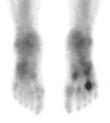|
Return to Articles Main Page
What Is A Stress Fracture?
Each day, the body produces new bone to replace the bone that is broken down by the stress of everyday living. Usually, this process is balanced, with the body replacing the amount of bone lost. However, this balance may become upset with excessive physical training. The body, due to several factors, may not produce sufficient bone. As a result, micro cracks, called “stress fractures” can occur in the bone. |

|
The most common cause of stress fractures is an abrupt increase in the duration, intensity or frequency of physical activity without adequate periods of rest. In addition to mechanical influences, systemic factors (such as hormonal imbalances), nutritional deficiencies, sleep deprivation and metabolic bone disorders may contribute to the development of stress fractures. Furthermore, some female athletes who train competitively develop eating disorders and/or amenorrhea (infrequent menstrual periods). Both conditions may lead to a low estrogen state with resultant decreased bone mineral density and an increased risk of stress fractures. It should be mentioned that these fractures can also occur for no known reason.
Stress fractures are frequently seen in military recruits and athletes, especially runners. Although stress fractures have been described in nearly every bone in the human body, they are more common in the lower extremity weight-bearing bones.
How Do I Know If I Have A Stress Fracture?
Stress fractures produce pain in a limited area over the point of the bone where the fracture has occurred. The pain is increased by activity and relieved by rest. Bone tenderness is the most obvious finding on physical examination.
X-rays are usually not helpful in diagnosing an early stress fracture as the bone often appears normal as the micro cracks are not visible. |

|
After several weeks, the bone begins to repair itself and will then demonstrate a healing reaction on x-ray (see figure).
The diagnosis of an early stress fracture can usually be confirmed by a bone scan or magnetic resonance imaging (MRI). In a bone scan, a radioactive substance, called a “tracer” is injected into the patient’s bloodstream. All of the bones will absorb some of the tracer, but if a bone is repairing a stress fracture, it will absorb more of the tracer at the fracture site and will appear darker (see figure).
How Is A Stress Fracture Treated?
Stress fractures usually require a rest period of 1 to 6 weeks. This is defined as limited weight-bearing progressing to full, unrestricted weight bearing. Return to activity should be a gradual process. Low impact activities, such as swimming or biking can be performed to maintain cardiovascular conditioning once the pain subsides. When the patient can comfortably perform low impact activities for prolonged periods without pain, high impact activities may be initiated.
Anti-inflammatory medication and/or physical therapy may also be prescribed depending on the patient’s symptoms.
The treatment of a stress fracture in the office of a podiatrist stresses the rapid reduction of pain and disability. The fracture generally heals in 6-8 weeks but during that time there often is significant pain and disability. If this can be reduced, the patient will be able to return to his/her daily routine in more normal footgear sooner thereby improving their quality of life as the fracture heals. This is accomplished by injecting a local anesthetic with a short-acting steroid. Contrary to the usual opinion, this procedure does not delay healing time but produces the opposite effect.
How Are Stress Fractures Prevented?
Stress fractures in the athlete are best managed by prevention. Training errors, such as an excessive increase in intensity, are the most frequent culprit and should be corrected. New activities, such as hill running on a hard surface, may be contributing factors. Athletes, coaches and parents should be educated about the deleterious effects of overtraining. In addition, female athletes and their coaches need to be alerted to the adverse effects of eating disorders and hormonal abnormalities. The non-athlete should investigate sudden, pin-point swelling with pain.
Return to Articles Main Page
Our Services | Referring Physicians | About Us | Frequently Asked Questions | Blog | Articles
Surgical Animations | Links | News & Press | Photo Gallery
Contact Us | Home | Legal Notice | Privacy Statement | Site Map
Copyright © Buffalo Medical Group P.C. / Podiatry Affiliates
Website Design, Maintenance and Hosting by Catalyst Marketing / Worry Free Websites |
